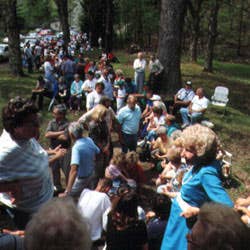
The Helvetia Ramp Supper
Ramps grow wild throughout the Appalachian Mountains. The leaves resemble those of lily-of-the-valley and the bulb is like a scallion, while the flavor is an earthy mix of garlic, leek, and dandelion greens. Ramp season is short, from the end of March to early May, after which the leeks grow too strong in flavor. Ramps are delicious in various preparations; they are also notorious for their odor, which lingers on the breath, and in the air near where they have been cooked. And they are cooked, and otherwise prepared, in dozens of ramp recipes—among them, ramp Bloody Mary, ramp chili, ramp home fries, ramp vinegar, ramp oil, ramps and eggs, ramp meat loaf, ramp-flavored bourbon, ramp pie, and even a raw ramp-and-corn bread sandwich.
Because ramps are one of the first growing things to appear in Helvetia after the harsh snows of winter, eating them is a kind of rite of spring. Every April, ramp suppers are held statewide in West Virginia—in community halls, Elks' Clubs, elementary schools. The Helvetia Ramp Supper is particularly popular. People come from all over the country to attend it, waiting in line for hours to savor both the food and the spirit of the event, which is like a warm gathering of some giant family. Bowls and platters are passed down the long tables as children run back and forth from the kitchen to replenish them while their parents and grandparents man the huge black stoves. It's an occasion where you can eat your fill of country ham, fried potatoes, corn bread, cole slaw, beans, applesauce, and fried ramps—a celestial combination.
The Helvetia Ramp Supper is a community effort. The most arduous work is cleaning the dozens of bushels of ramps still clumped with dirt. (The roots grow so deep into the stony soil that trowels, hoes, and sometimes even screwdrivers are used to dig the bulbs out intact.) The ramps are dug over a three-week period by several local families—so secretive about their sources that they leave before dawn to venture into the woods to seek them.
All of Helvetia pitches in to clean the ramps, peeling the bulbs of their outer skins, removing the roots, and rinsing them repeatedly. In the basement of the community hall, volunteers, paring knives in hand, face each other as they straddle benches, talking and gossiping with piles of dirty ramps between them. Behind the hall, several men tend a wood fire under two enormous iron kettles suspended from booms. The ramps are parboiled in batches, stirred with a pitchfork, drained through an oilcloth punched with holes, and then chopped with a hatchet. They will be frozen until the day of the supper, when they are fried in rendered bacon fat.
Just before the supper, preparations reach a fever pitch as the Helvetia Farm Women's Club oversees the preparation of huge quantities of ingredients. Food is cooked on all the burners of the community hall's three stoves. A crowd of men and women work elbow-to-elbow in the cramped, hot kitchen, talking and laughing as they fry potatoes, wash pots, refill serving dishes. The hall fills with the aroma of baking corn bread, ramps, and ham—a sublime torment for those still waiting in line to eat. After dusk, as the last folks are served, diners wander through town in the waning light, nap in cars, or nip bourbon by the river. Upstairs in the hall, fiddle music kicks off a square dance that will rock the wood-frame building for hours. Grandmothers dance with grandsons and farmers with city folk, as the wild strains reverberate off the darkened hillsides.
Keep Reading
Continue to Next Story










